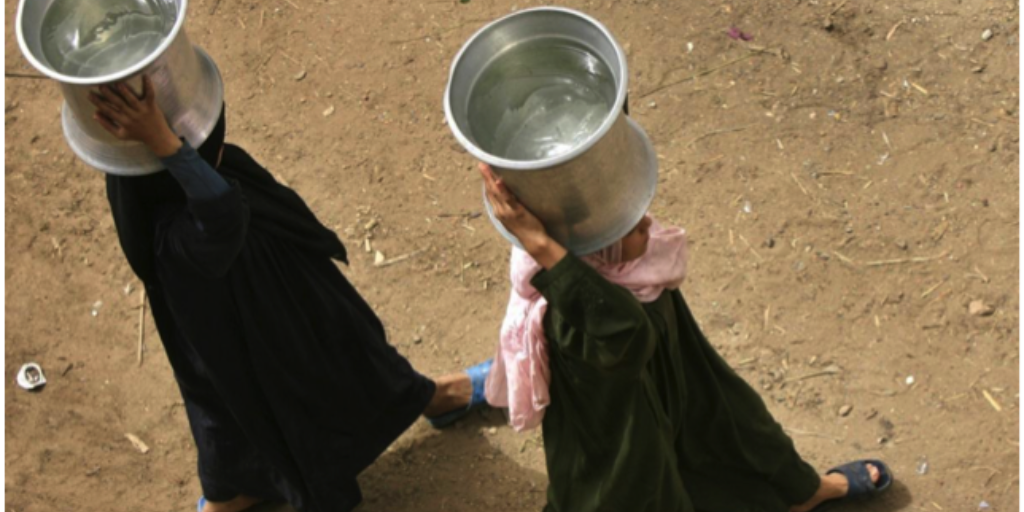The Middle East and North Africa (MENA) is a naturally diverse region. It includes some of the world’s largest reserves of oil and fossil gas, but it is poor in water resources and arable land. It is the only region in the world today to suffer from critical freshwater scarcity. In Egypt in particular, the low water availability, in combination with a fast-growing population and inefficient water use – especially in the agricultural sector – leads to an average amount of water per capita that is far below the scarcity level. What’s more is that the total water demand is forecasted to increase by 50 percent between 2000 and 2025, while per capita water availability will fall by half by 2050.
It therefore doesn’t come as a surprise that the major environmental challenges that the region faces and will continue to face are water scarcity, land degradation (including desertification), coastal and marine environment degradation, and air pollution – all amplified because of climate change. Within any nation, water scarcity is a major constraint to development. Therefore, water quality is emerging today as an important issue and is of growing concern to all levels of the public in Egypt.
Environmental degradation & water scarcity in Egypt and what that really means
Climate change and lack of freshwater impacts many social issues such as poverty, economic development and public health, all of which are key for development in Egypt.
Over the past decade, the height and strength of sea and ocean waves have increased and climate change may double the strength of storms and hurricanes and alter their courses. Such an increase will intensify their destructive force in coastal areas, as has been shown by many scientific projections. At the local level, no study has confirmed any notable imbalance of the prevailing natural events, including temperatures, winds, waves, hurricanes and winter storms, which shows a huge gap in the literature on this subject today.
The vulnerability of Egypt’s population
The severity of health hazards and consequences due to climate change will increase as a result of the vulnerability of Egypt’s population; it is already expected that this will have a stronger impact on children, the elderly, the poor and farmers in the coastal zones. Egypt’s population is mushrooming at an alarming rate and has increased by 41 percent since the early 1990s. Recent reports by the government suggest that around 4,700 newborns are added to the population every week and future projections say that the population will grow from its current total of 98.7 million by the year 2025.
In this context, the Egyptian Organization for human rights stated that roughly 38 million people in Egypt drink polluted water. They also affirmed that the industrial water wastes that enter the Nile are approximately 4.5 million tons per year. Globally, industrial waste water represents the main source of water pollution.
The Nile River is the traditional receptor of waste and drainage waters generated by different activities. Industrial waste waters are considered among the major sources of environmental pollution, endangering public health through direct use as well as feeding fish that live in the polluted streams. It is estimated that more than 400 factories continue to discharge more than 2.5 million cubic meters per day of untreated effluent into Egypt’s waters.
On July 28, 2010, through Resolution 64/292, the United Nations General Assembly explicitly recognized water and sanitation as a human right and acknowledged that clean drinking water and sanitation are essential to the realization of all human rights. This is why the Egyptian Organization for Human Rights also points out the increasingly numerous poisoning cases in Egypt. This issue has been measured by the NGO along 3 different cities: Cairo, Giza, and Qaliubiya. Qualiubiya comes first with 50 percent of the poisoning cases caused by water, then Cairo with 35 percent, and the last one is Giza with 12 percent.
The Egyptian organization for human rights also states that approximately 100,000 people die everyday due to cancer caused by water pollution. Another 15,000 people get kidney failures also because of water pollution. These are only estimates of Egypt’s hydraulic crisis.
Egypt’s outdated water distribution network

Finally, it is important to note that the Egyptian water distribution network depends on the patterns of water output emerging from the High Dam, which is based on a set of regulations in accordance with the following year’s flood forecasts. These regulations date back to the 1959 Nile Waters Agreement between Egypt and Sudan. Climate change will expectedly change the water inflow of Lake Nasser, which is currently the main reservoir of the High Dam. Based on the estimations and calculations of 1959, and assuming that the allocation ratio between Egypt and Sudan will be utilized to divide the Nile River waters under the conditions of climate change, it is likely that, upon preparation of the water balance for 2025, there would be a 5.8 billion cubic meter deficit.
Egypt receives less than 80 mm of rainfall a year, and only 6 percent of the country is arable and agricultural land, with the rest being desert. This leads to excessive watering and the use of wasteful irrigation techniques such as flood irrigation (an outdated method of irrigation where gallons of water are pumped over the crops). Nowadays, Egypt’s irrigation network draws almost entirely from the Aswan High Dam, which regulates more than 18,000 miles of canals and sub-canals that push out into the country’s farmlands adjacent to the river. This system is highly inefficient, losing as much as 3 billion cubic meters of Nile water per year through evaporation and could be detrimental by not only intensifying water stress but also by creating unemployment. A further decrease in water supply would lead to a decline in arable land available for agriculture, and with agriculture being the biggest employer of youth in Egypt, water scarcity could lead to increased unemployment levels.
The solutions of today and tomorrow
As early as the 1990s, the Egyptian authorities realized the vulnerability of the country’s coastal zone to the potential impacts of climate change. In response, the government has established a National Center for Land Use and a National Committee for Integrated Coastal Zone Management, staffed by selected representatives from various ministries and charged with coordinating and implementing integrated planning among relevant agencies.
Furthermore, Egypt as an international actor in the fight for sustainability was represented at The World Conference on Disaster Reduction (WCDR) held in Japan in 2005, in accordance with the resolution adopted by the United Nations General Assembly. During this conference, the Hyogo Framework was established for the period of 2005-2015 with the aim of enhancing the resilience of nations and communities in the face of disasters. This framework included a strategic approach to reduce vulnerabilities, risks and hazards. It aimed at tackling the fact that climate change will threaten people’s lives, proprieties and livelihoods and may also compromise the achievement of their development goals. The National Committee for Crisis/Disaster Management and Disaster Risk Reduction was thus created in affiliation with the Information and Decision Support Center (IDSC) in Egypt.
with the Information and Decision Support Center (IDSC) in Egypt.
However, the severity of these environmental issues is not adequately taken into account by Egyptian authorities and policymakers today. Nonetheless, different ideas have been considered and put into place. These primarily include: Keeping the water level in Lake Nasser low; increasing water storage capacity; improving irrigation and draining systems; and changing cropping patterns and farm irrigation systems.
Finally, encouraging data exchange between Nile Basin countries and developing Circulation Models for the prediction of the impact of climate change on the local and regional water resources have been launched. However, these efforts unfortunately lack in efficiency. Today, Egypt does not recognize a recent agreement signed by Burundi, Ethiopia, Kenya, Rwanda, Tanzania and Uganda that seeks to allow irrigation and hydroelectric projects to go ahead without Cairo’s consent. Ethiopia, for instance, is planning a series of dams along the Nile to generate electricity, the first of which is the Ethiopian Renaissance Dam launched March last year. This dam in particular has raised concerns about its environmental and human impacts because it would reduce Egypt’s current share by five billion cubic metres annually.
A possible solution would be for Egypt to cooperate with Ethiopia and buy electricity, which is why a Declaration of Principles was signed between Egypt, Sudan and Ethiopia for better cooperation in the future. Yet, the seemingly unstable political situation in Egypt today is becoming more and more of an obstacle for long-term improvements in national policy frameworks.
electricity, which is why a Declaration of Principles was signed between Egypt, Sudan and Ethiopia for better cooperation in the future. Yet, the seemingly unstable political situation in Egypt today is becoming more and more of an obstacle for long-term improvements in national policy frameworks.






Comments (0)